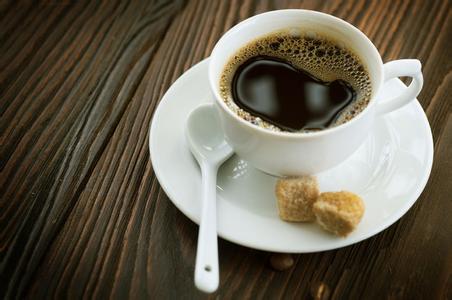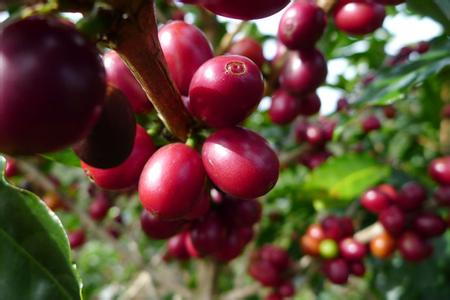Is China, the country that drinks the most coffee per capita in the world, shortlisted?

Walking around the streets of the United States, you will immediately feel that the United States is a country immersed in coffee: a Starbucks can be found on almost every street corner; McDonald's is turning into McCoffee; Duncan doughnuts are also becoming the most frequented place for breakfast. As you all know, the world's largest coffee chains all originate in the United States, so it's not surprising that the United States has become the world's largest consumer of coffee, so it's hard to believe where else in the world people drink more coffee than Americans. Indeed, in terms of annual per capita consumption, the average annual coffee consumption of Americans is only moderate among the world's largest coffee drinkers.
In 2013, Euromonitor released a list of "coffee consuming countries" based on annual coffee consumption per capita. Let's take a look. In terms of annual per capita consumption, people in those countries around the world drink coffee the most.
The world's first coffee drinker was Yemen in the 15th century, but when we talk about early coffee drinkers, the first thing you think of is Paris or Rome, but none of these places are among the top 10 per capita annual coffee consumption in the world.
No. 10: Brazil: per capita 4.8 kg / year (1.32 cups / day / person)
Coffee is Brazil's national drink, and Brazil has been the world's largest producer of raw coffee beans for more than a century. Therefore, it is not surprising that Brazil's per capita coffee consumption is among the highest in the world. The average Brazilian consumes 4.8 kilograms of coffee beans per year, which is equivalent to 1.32 cups of coffee per person per day. In terms of per capita coffee consumption, Brazilians ranked tenth in coffee consumption. Brazil is the only country that produces and sells coffee beans in the top ten.
As the world's largest producer of raw coffee beans, Brazil has more land for coffee cultivation (2339630 hectares) than the entire country of Israel, and because Brazil's population is also among the highest in the world, Brazil's total coffee consumption is dazzling, consuming 2191596000 kilograms of raw coffee beans in 2012.
No. 9-Belgium: 4.9 per capita per year (1.35 cups per day / person)
Speaking of Belgium, you may see waffles and beer. In fact, chocolate in Belgium is as old as coffee, with an average of 1.35 cups of coffee per person per day.
As a former colonial empire, Belgium grew coffee in the colonies of Congo and Rwanda to meet Belgian domestic consumption. Nowadays, there are countless street cafes in Belgium, and it is most common to have a cup of coffee with its famous waffles anytime and anywhere.
8-Germany: 5.2 kg / year per capita (1.43 cups / day / person)
German coffee first sprang up in the northern port city, and the first coffee shop appeared in 1673. The coffee shop is a gathering place for intellectuals and the rich. The famous musician Bach has an inextricable bond with coffee, and he even wrote a coffee oratorio.
Today, Germans drink an average of 1.43 cups of coffee a day, consuming a total of 445197000 kilograms of coffee a year. In other words, the population of Germany is seven times that of Belgium, but the total coffee consumption of Germans is 7.5 times that of Belgians.
No. 7-Denmark: 5.3 kg / year per capita (1.46 cups / day / person)
If the Nordic countries are the king of coffee, Denmark is the prince of coffee, with Danes drinking an average of 1.46 cups of coffee a day.
Like other Scandinavians, Danes traditionally drink coffee at dinner or on special occasions. Not only do Danes drink more coffee, but Danish coffee is the sixth most expensive in the world. So the money that Danes spend on coffee is also sea. There is also a coffee maker in Denmark, Dodum (which China calls the Bolton coffee maker-French kettle, although it was invented by the French) is famous.
No. 6-Serbia: 5.4 kg / year per capita (1.49 cups / day / person)
Traditional Turkish Coffee-Thinkstock.com
Serbs drink strong black Turkish coffee, which is famous for eating with a fruity dessert. Turkish coffee is made by adding water to a Turkish pot of finely ground coffee powder. as soon as the water is boiled, the pot is removed from the fire and repeated two or three times before it is boiled, and then it is not filtered and poured directly into a cup for human consumption. Serbs drink an average of 1.49 cups of coffee a day, ranking sixth.

No. 5-Austria: 5.5 kg / year per capita (1.51 cups / day / person)
The first caf é in Austria appeared in 1638, and its waltz and classical music are world-famous. Austrian cafes have a special atmosphere and culture. Most cafes offer small plates of delicacies such as sausages and desserts such as Linz nut cakes. Guests can read free newspapers and stay for hours. In 2012, Austrians drank an average of 1.51cups of coffee a day, ranking fifth, with 63984000 kilograms of coffee consumed throughout the year.
Next time you go to Vienna, be sure to try Kaisermelange: mix the egg yolk with honey, slowly pour coffee on top, and finally add whipped milk or cream, and, more authentic, add some brandy.
No. 4-Slovenia: 6.1 kg / year per capita (1.68 cups / day / person)
Slovenian winter is accompanied by coffee-Thinkstock.com
Like Serbia, Slovenians drink Turkish coffee, which they call "Tur coffee ka Kava", which is very strong and drinks in small cups, sometimes with milk or whipped cream. Served very strong in tiny cups, sometime with milk or whipped cream.
Like many other Europeans, Slovenians like to shop in cafes (locals call them "kavarana"), drinking 1.68 cups of coffee per person per day, ranking fourth. 2 million people across the country drink 9327000 kilograms of coffee a year!
No. 3-Netherlands: 6.7 kg / year per capita (1.84 cups / day / person)
In 1616, the Dutch became the first European to successfully acquire a coffee tree from Mecca in Yemen (Peter van der Broecke). From then on, the Dutch coffee cultivation began, and its colonies Java and Java and Suriname became the main suppliers of coffee in Europe.
Nowadays, cafes in Amsterdam also offer a famous "specialty" marijuana (Marijuana), but don't let this block your view. The Dutch coffee culture is rich. The Dutch drink an average of 1.84 cups of coffee a day, ranking third in the world.
The Dutch have a special "coffee time" ("Koffietijd": Coffee Time) at home, usually with cookies and cakes. Interestingly, the Dutch coffee culture varies according to different religions in the north and south. The north is an area where Protestants gather. Drinking coffee with only a small cookie is regarded as a modest gesture, while the south is traditionally the territory of Roman Catholicism. Drinking coffee must be accompanied by a big sweet pie.
No. 2-Norway: 7.2 kg / year per capita (1.98 cups / person / day)
Northern Norwegian brew coffee on a bonfire-experiencenorthcape.wordpress.com
Like most Nordic countries, coffee in Norway first became popular among the rich in the early 18th century, and although Norway was still a poor country at that time, the advantage under Danish rule was that Norway had plenty of cheap coffee to drink.
In Norway, we usually drink black coffee for breakfast and dessert after dinner. Norwegian people often invite friends to get together for coffee, cakes and cakes. The average Norwegian drinks nearly 2 cups of coffee a day, ranking second in the world, while Norway has a population of about 5 million, so Norwegian consumed 36472000 kilograms of coffee in 2012. If you have a chance to go to the Norwegian countryside, don't forget to try their "Karsk" drink, a cocktail made of light coffee and vodka. Don't be afraid, if you think the drink is too strong, light a fire to burn some of the alcohol.
No. 1-Finland: 9.6 kg / year per capita (2.64 cups / person / day)
If you have really seen Finns drinking coffee, you will think that Finland's per capita figure of 2.64 cups per day is on the low side. If children are not included, then its per capita coffee consumption has increased sharply.
Finns drink coffee almost all day, and most unions require coffee breaks during work. Some special occasions and church lunches usually have sandwiches, bread, cookies, pastries and endless coffee.
The most popular coffee in Finland is light-roasted coffee, which is lighter than anywhere else in the world, probably due to the fact that Finns bought raw coffee beans to roast at home in the early days, and their traditional way of making coffee is to brew it back and forth in Turkish style. Finnish coffee culture is influenced in many ways. If you are in Finland, do not ask for decaf, it is not at all, you also look too foreigner.
Source: Top 10 Coffee Consuming Nations (March 18, 2015 By Kristine Bernard)
Source: Huang Wei boutique coffee roasting blog http://blog.sina.com.cn/s/blog_692bf2b70102vzdt.html
All rights reserved. Please indicate the source of the reprint.
Important Notice :
前街咖啡 FrontStreet Coffee has moved to new addredd:
FrontStreet Coffee Address: 315,Donghua East Road,GuangZhou
Tel:020 38364473
- Prev

Starbucks most popular coffee TOP5 must point list recommendation Starbucks coffee price list tastes good recommend
The most exciting thing for the editor this week is that the new Starbucks store in Luoyang will be officially opened on May 15! After the opening, there will be a large number of limited gifts coming. The good news has spread all over Luoyang. However, do you know which coffee is the most popular in Starbucks? Today, the editor will take you up.
- Next

How many of the top 10 top quality coffee beans in the world have you drunk?
Panamanian jade geisha first exhibited amazing fragrance in 2004. Its orange-floral charm and deep caramel aroma dominated the major cup test competitions, and its value doubled, setting off an upsurge in the cultivation of geisha in Central and South America and opening up new flavor areas of Central and South American coffee. Bourbon pointed body unique litchi flavor and citrus flavor, fascinated ancient and modern literary dignitaries, is today the lowest output, the lowest caffeine, the highest price
Related
- What is the standard process for the purpose of coffee cup testing? What is the difference between hand-brewed coffee and cup testing?
- How to use hand-brewed coffee paragon small golden balls? How does cold coffee lock in the aroma of coffee?
- Is American coffee black? What is the difference between American coffee and drip coffee?
- Unexpected! Well-known tea beverage brand Lele Tea will withdraw from the Zhengzhou market!
- Starbucks enters the fashion and beauty industry?! Netizen: Give me an ice American eye cream
- Why can American refills for free? The difference between Americano and American drip pot coffee
- Being chased out of the rain in front of Starbucks?! Store: Sheltering from rain under umbrellas poses a safety hazard
- The white moonlight has changed?! Lucky launches "Big Winter Pear American"
- Hand-brewed coffee three-stage method, high-sweet and universal brewing method to share! What does the high sweet water level of hand-brewed coffee mean?
- What is the difference between raw, refined and full espresso coffee? How to extract espresso and taste good?

